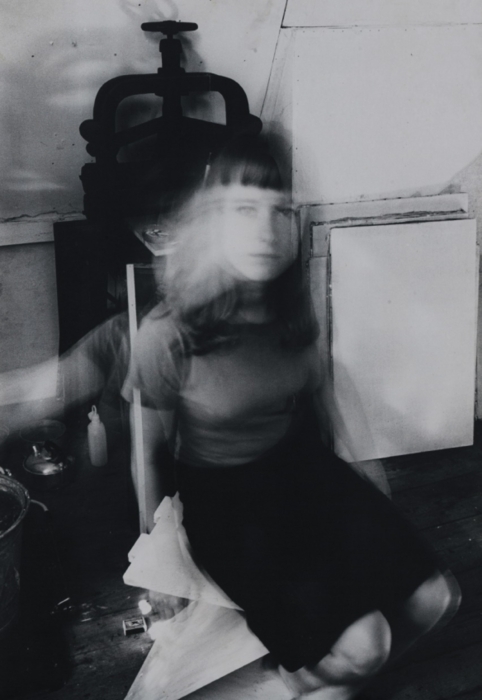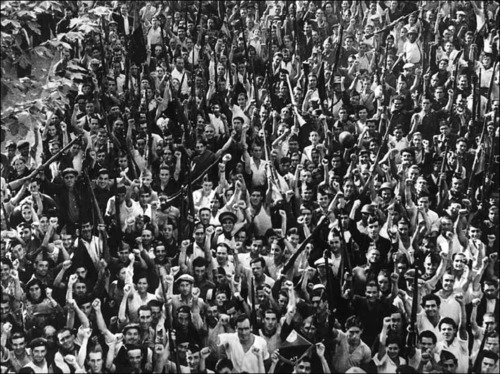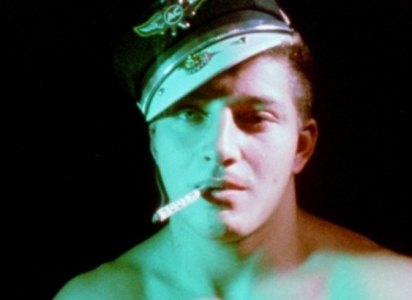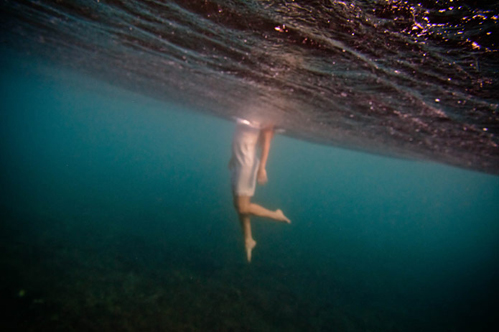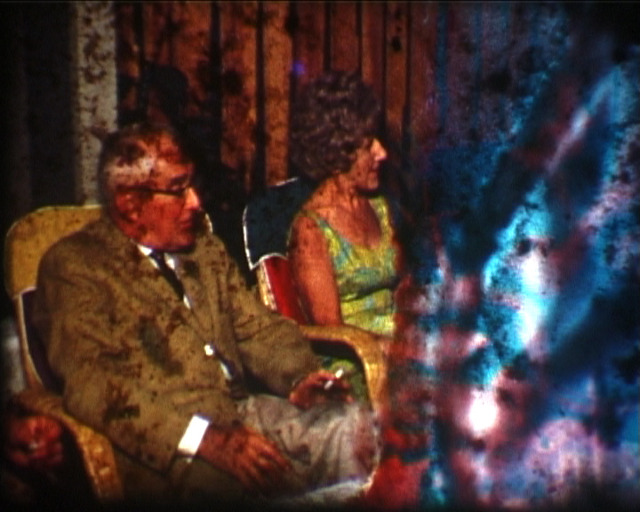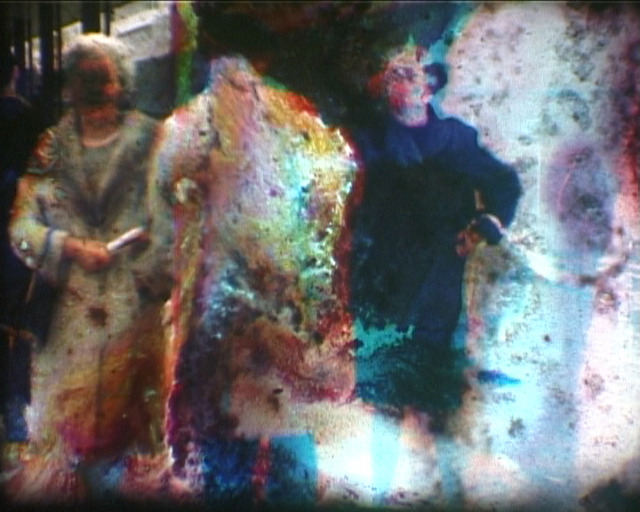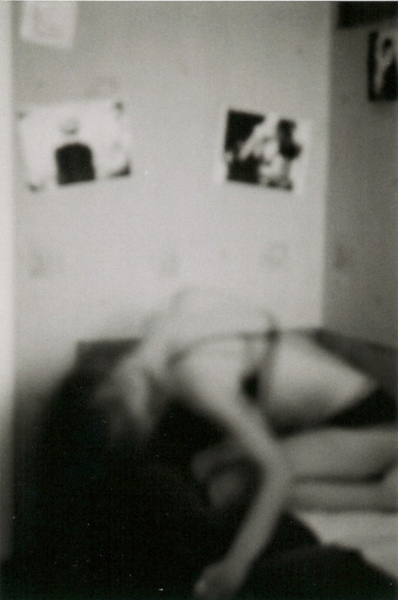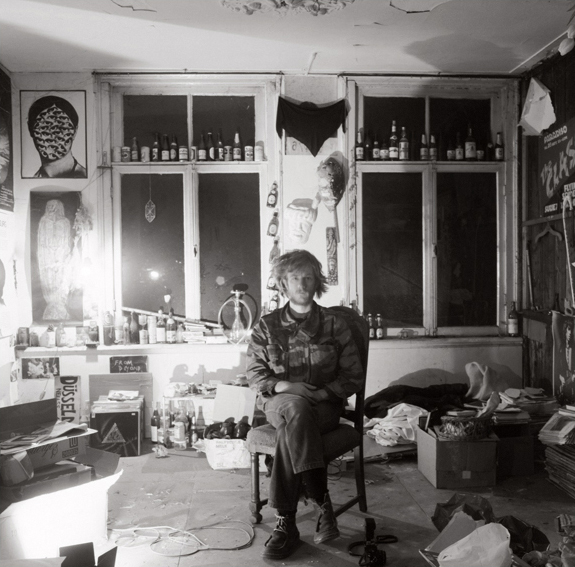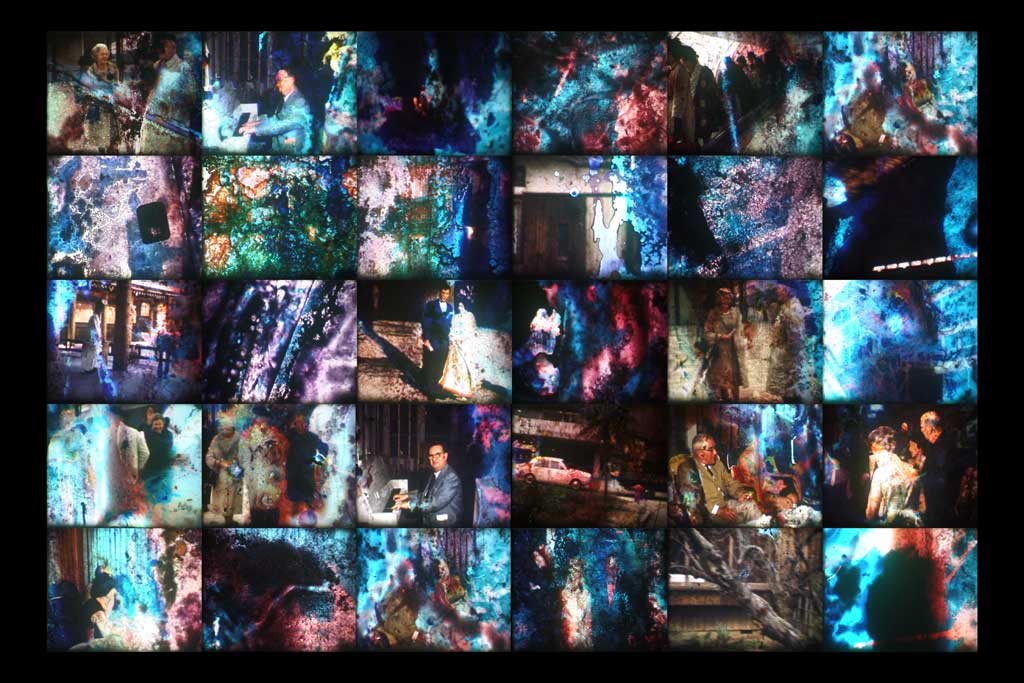
I Know The Whisper: an interview with Fred Pelon by Dirk de Bruyn
DdB: I’m in Fred Pelon’s little studio, seemingly down in the catacombs of Amsterdam, to talk about his work. When did you start making films?
FP: I started super 8 filmmaking in 1983. After becoming involved in programming art house and experimental film, I slowly started to become interested in making experimental work instead of the more documentary work I used to do.
DdB: How did you start making documentaries?
FP: I began from my engagements with political movements, and saw film as a tool to inspire action, for instance, it could allow people to become involved with the solidarity movement in Nicaragua. It was a propaganda tool.
DdB: Were you been involved with political action before working with film?
FP: Yes, it was after my first visit to Nicaragua that I started making films, and also after being involved with the Dutch squatter movement, an anarchist movement in the late 1970’s and beginning of the 80’s. It was there that I met the documentary filmmaker Johan Van Der Keuken who had come to the squat to make a film. My fixed ideas about media were radically changed. I saw that you could work with film and be engaged not only superficially, but go into the depth of a certain situation, and become a part of it. He was an important example that I can recognize now as I look back, though I’m not very familiar with his work in general. I was interested in his methods and his personality. He very gentle, interested, humanist, curious.
DdB: He showed how you could respectfully put yourself in a situation that would remain true to the story being told. I guess that was something that you could take with you to South America.
FP: I went to Nicaragua as part of a gathering that was received in a particular way as a propaganda group from abroad. It was like Johan Van Der Keuken coming to film in the squat.
DdB: What did you do with the film you produced when you came back to Holland?
FP: I would go to solidarity groups with my super 8 projector. With assistance from another super 8 filmmaker, I added propagandistic music and songs, and produced a very simple montage. We visited solidarity groups in many cities and the films would arouse enthusiasm for going there, or becoming involved in the Sandinista revolution. There was a lot of left wing interest in these issues. People were looking for a kind of example because revolutions in the Soviet Union and China had become oppressive and totalitarian. Nicaragua was a relief in that sense, because the revolution established a moderate regime without a lot of bloodshed.
DdB: Your exhibition methods reminds me of the early Union-based film units in Australia. Films would be shown in factories. It was about empowering the workers through the workplace.
FP: The exhibitions drew on that tradition and continued especially in the period when there was no television or internet. It was a major tool for propaganda and education, and much of Nicaragua looked as if it was in the 1920s or 1930s. When I returned to Nicaragua in 1985 with my film I had to find a projector and a gasoline powered generator before returning to the village in the mountains. When they gathered the children sat up front, then the women, then the men with the guns in the back, and then me with an old fashioned projector.
DdB: What was the reaction of people seeing themselves on the screen like that?
FP: Complete amazement. There was a city not far away so they had all seen cinema and television. But they had no electricity themselves. The amazement was that in their own village, in their own school, they were watching images of themselves. And also the war had taken away a very beloved person. He was unofficially the Mayor of that small village. He had been killed during an attack and he was present in that film. There was great emotion from the older people in the audience and his family when he appeared on screen. Of course, they have seen photos. But here he was moving and smiling. The moment when I saw this happening was the highlight of my cinema experience. Later I became a film programmer and it started there in a way.
DdB: So what was it that made you move into a more personal and experimental filmmaking?
FP: It was partly because I started with super 8 filmmaking, which was complicated but not impossible, and at least it was cheap. I managed with no education, only a small book entitled, ‘How to make a film.’ I didn’t have any outside support, though people around me were involved with filmmaking. They started to work with video. I couldn’t cope with the way you had to edit as I was used to cutting up strips of film and pasting them together. After I came back to Holland I was still making films, but they were not yet connected to my personal experience and inner life.
When I was involved in cinema programming from 1995 to 1998 I saw a lot of personal experimental film and video that triggered my desire. It meant I could go my own way because I had always been dependent on others. And then digital video arrived and I saw the possibilities of combining the computer and the super 8 camera and that was it. After the first experiment, I knew it would work.
DdB: Are there any particular films that you could give as examples of formative work you’d seen while programming?
FP: The Smell of Burning Ants (21 minutes 1994) was one, and many others
DdB: I can see how Jay Rosenblatt’s work would influence The Dutch Act in terms of its structure, the way it constructs stories using various languages.
FP: There’s an enormous distance between the academic, intellectual approach that he uses which for me is not really there firsthand. It’s close in a psychological sense, and I love it, but I don’t see me or my approach in it. Of course it’s interesting to see work that carries similarities to your own, and that maintains differences. This is the work that can inspire because it makes clear where you are.
DdB: It’s an influential film that shows a deep understanding of the history of experimental film.
FP: This film is like a workshop on its own but I’m also influenced by Kenneth Anger because he is so free with music.
DdB: One of the things that stays with me about Kenneth Anger is his use of time. In the dress up scene in Scorpio Rising (28 minutes 1964) there’s such a sense of real time that really opens up the way the body is presented. Time also opens the body in your films, in Hoela Loop (6.5 minutes 2004) for example. You admit a meditative use of time that is circular and looping like its subject. Zapatos (8 minutes 1999) also carries this sense of time. Was that your first experimental film?
FP: Yes, it was based on material filmed in Central America. I used this documentary footage and introduced another kind of language. I started to play with this footage, re-shooting the super 8 onto super 8, and then mixing it with found footage. It used to be possible to buy decorative material to party up home movies and I used these stars and stripes and diamonds and flowers, which are very remote from the original political meaning of the material.
DdB: That graphic layer reminded me of Russian formalism. It could be said that you used your own film from a previous period as if it was found footage.
FP: Yes, found footage includes my own footage. They belong to the same domain.
DdB: A lot of people go around the world these days with their video cameras capturing images and making layered impressionistic films. But your relationship with the places and material in Zapatas is not a superficial one.
FP: When I returned to Nicaragua to film for the second time I did not feel like an outsider even though in many ways I was. It makes a lot of difference in how I filmed, people were very at ease with the way I worked with them. Thirty people from a foreign country joining farmers in their harvest creates a completely harmonious situation. I was part of a very special event.
DdB: What were you trying to capture in Zapatos?
FP: Impressions of people in violent times. Zapatos is about showing ordinary people and ordinary moments, but obviously in a violent context. You see many guns in the film though they’re not really a threat, people walk around with them casually. It’s very impressive to go from Holland to countries at war like Nicaragua, El Salvador, Guatemala. I’ve gone a few times but I could always come back to Holland where it’s safe. For these people, the violence was as familiar as day and night. The film is a poem about ordinary people in violent times.
DdB: There’s something very yearning about it, perhaps it’s the music.
FP: The music goes on and on, that’s the idea. When you go for the first time and there’s revolution, there’s this naieve idea that everything’s going to change. People are going to have peace and happiness and justice. But every year I went back things were getting worse and time is very slow in the countryside and the poverty is hardly changing. Day after day, year after year, the same teasingly slow movement of events require patience and endurance. That’s the music you hear.
DdB: It finishes strongly on the last shot when you’re following the soldier through the landscape. It is an elusive body that is being chased. The music also tries to find something that is slightly out of reach. What was your thinking in terms of that final sequence?
FP: I wanted to slow it down. There is a flow of superimposed images which gradually decelerates and gives the feeling that all this will continue, the mountain, the walk, the revolution. The film has been criticized for being too long.
DdB: At that point the sound fully becomes the picture, entering the body of the soldier. What about your next film? The one about your grandfather was the next one I looked at. I don’t know how that fits in. That was mostly found footage, wasn’t it?
FP: Yes, Double Trouble Same Song (11 minutes 2001) consists of 80 per cent found footage and 20 per cent shots of my grandfather in different lights.
DdB: The portrait footage of him is very slow and arresting.
FP: During the last five or six years of his life nothing much happened. He was sitting and sleeping and sitting and sleeping. I would see him a lot because I helped take care of him. I would sit next to him. He would sing a song. Nothing much would happen. So I would start to wonder what was going on in his mind. Sometimes he would give me some moments of what he was thinking about with a song. Mostly he would communicate by song. Nothing real was happening, though his mind was full of flashes and memories.
DdB: Why do you think he had flashes and memories?
FP: Because he would sit in silence and then suddenly move his finger like this or tell an old story or start to sing. He was not very lively generally but there were moments triggered by some happiness or pleasure of being with someone. Most of the time, he would sit alone. He was sensitive to the presence of my sitting there. He would never really tell a story, it was all fragmented in his last years.
DdB: Those images of your grandfather reminded me of a short film by Jan Willem Van Dam about his parents which had a similar feeling of respect. Apart from footage you made of your grandfather, the film consists largely of found footage collected over a long period of time. How did you find that material?
FP: Flea markets of course. And there are some film collectors who buy from other collectors, but who are only interested in 35 and 16 mm, so they set aside the smaller gauges. I know a lot of people involved with cinema and programming and word has got around that I’m open to receive many kinds of material.
DdB: So there’s a bit of a network around you. Perhaps even a community?
FP: There is a sense of community concerning super 8 filmmaking and found footage. I’ve even managed to organize a program for people to come together. It’s small but it’s there.
DdB: You introduce text underneath the image of your grandfather describing his songs and conversations. He asks you, “Have you been here before?”, and you say of course that you have. That made me think that he was suffering, and wasn’t clear about chronology and memory. You said that he had Alzheimer’s?
FP: Yes, but his lapses and lucidities came in moments. Especially in his last year he would pose this question to me: Have you been here before? But sometimes I would come and he would immediately know who I was.
DdB: The whole process of how the images were collected is interesting. The flea markets hold a kind of collective memory of Dutch history in super 8. The way you arrange it suggests a demonstration of your grandfather’s non-linear memory.
FP: Yes, the home movies run from the 1930s to the 1970s. He was also a person very interested in erotics, his stories or jokes often had a double meaning. So I the collage includes erotic excerpts in which I tried to combine my own observations and obsessions with what I imagined would have been in his mind. Time is not linear. Time is a product of our thinking and this becomes more pronounced as one grows older. Events trigger recollections which are not chronological.
DdB: There’s an emotional thread rather than a chronological one.
FP: Yes, an emotional line. For instance you see these two funny skinny men doing a dance act. This is from the 1930’s. My grandfather was 40 years old then, already middle aged. He wouldn’t go to the jazz clubs where this stuff was filmed, but he would go to the Kermis (Carnival). My grandfather had a difficult time during the war and afterwards. He was treated as a collaborator and spent six months in a camp after the war.
I found footage of soldiers arriving, and then show a woman who has her bicycle seized. The story of how the invading Germans stole bicycles was told to me again and again when I grew up.
DdB: The found footage montage exists as a story trigger, the story itself is suggested but not played out in your film. Usually a film is constructed to elicit feelings held in common from an audience, but the way you present these images allows people to take away their own story. I’m struck by your remarks about the feelings which impel your making, are you concerned that the audience also receive these feelings? What arrives for the strangers in the theatre?
FP: In Double Trouble Same Song it’s not really so difficult to grasp, they see my grandfather sleeping and dreaming. The pictures show how I made the film and my emotions and his imagined dreamings.
DdB: It may be open in terms of the way it can be interpreted, but the emotional truth is very specific. When you are making a film, do you start with an awareness of those feelings?
FP: I start with crying and when it’s finished, I lop my head off.
DdB: Is the making of a film is an emotional journey?
FP: Yes. The films are a by-product of my growing up and dealing with myself and my not self. Getting to know and accept my not self, the no self. The films support me economically, they’re a by-product. They give me some way to communicate, and to receive attention. I couldn’t live without some kind of acknowledgment from the community or outside world.
DdB: But you’re trying to give expression to something quite deep and difficult to get to.
FP: Yes, it’s impossible to get to.
DdB: But somehow it doesn’t occur to you when you’re making the film that what you’re trying to show can’t be shown, that what you want to say can’t be said.
FP: That’s a good thing. It keeps me busy and creates some happiness. I’m not really making films to further confuse people or to make them attend to negativity. This can also be a good thing but generally my work creates some kind of happiness. Even work like Schick or The Dutch Act, which are serious films about suicide, contain elements of humour.
DdB: The Dutch Act (24 minutes 2001) shows us subtitles drawn from internet chat rooms where people in conversation exchange questions and experiences around suicide. Sometimes these dialogues are very practical and humour unexpectedly arrives.
DdB: I decided to make work based on my experiences with suicidal moods and quickly recovered a source I used when I had this interest, which was news groups on the internet. When I started to use these news groups as a research domain, I thought the best way to translate this onto film was using the same text-based communication, which took the form of subtitles. At the same time there are images, but these tell another story, my story.
If you are not really sensitive to images, you may be reading most of the time while the pictures become a kind of wallpaper. Sometimes the images takes a long time to arrive or resolve or they can work as a memory which is building throughout the film. Having read the text, some time later in the film, you might see an image which has been mentioned.
DdB: There’s a dialogue between text and image going on. The story line compacts a lot of information, just like the internet does.
FP: The internet tries. I drew from the compacted character of the internet and made it ultra compact, a translation only possible in a film format.
DdB: How much information did you start off with?
FP: A great deal. I tried to find different angles from this community which was founded through a common obsession about suicide. During the first period I collected texts as a personal solution, hoping to become an expert. I shared their moods and was very depressed. Unconsciously I was doing research, but this was very supportive for the work I did two years later on the actual film.
DdB: How did the images come?
FP: It’s a very unprepared process, although for the first time in my life I wrote a research grant, so I had to present some structure of how I would go about it. And then I would just fantasize. I used example texts and tried to imagine about what kind of images I could make. This is how I started and from that slowly, slowly places came into my mind which I would visit and create material.
DdB: Is it important that you go to a certain place?
FP: Very important. Each location was a potential suicide spot. The train I filmed with the actor is an obvious example, but there are other scenes which included water or dykes, very Dutch landscapes. These didn’t immediately point up a method of suicide but for me the feeling was present. I had to go there and film many times. After seeing these pictures it then became possible for me to return and do some more concrete shooting. It started with an intuitive search and filming and the next step was deliberately making some shots which could work with and against the text.
DdB: You make a reference to a film called The Suicide Box (13 minutes 1996) which was about the San Francisco Bridge.
FP: It was made by the ‘Bureau of Inverse Technology’ (BIT). In my research, I started to look for films, and even put together a small screening program of films about suicide. The BIT film was mentioned in one of the suicide news groups so I got myself a tape from Chicago and it is mentioned in the film. This ‘anonymous entry’ was very much like one of the many unnamed contributions to the news group itself. Some things were invented (in the news group and in the film), but not in the sense that they didn’t occur. I was watching the film both ways, as a researcher, and also as an interested party. It’s a curious film about reality and fake.
DdB: There’s a parallel between your film and The Suicide Box in their text/image relations.
FP: It offered me a kind of direction although I arrived at a completely differently place. The aesthetics had their impact. During the 1990s with the proliferation of the home computer the combination of text and film became more common. It’s something which still fascinates me. Some people say that text shouldn’t be used at all, because film is not for reading. It’s a great law to break. I even have ideas to limit myself to using only the title software of Adobe Premier in order to make films.
DdB: A Lettrist attitude. There’s also a tradition in Canadian experimental film of using the poetic text to build your images around.
FP: While working full time as an experimental filmmaker I have mysteriously gained the support of the whole of Canadian experimental film history. There’s some kind of connection which is more than coincidental. When I was just starting and trying to find some identity or form, I couldn’t find any structures of support (and I’m not talking about money). I connected with Toronto through my work as a programmer and when I went there it was as if I had found a second home as an experimental filmmaker. They spoke my language. The situation has changed more recently in Holland for me, and generally for experimental filmmakers. But in the beginning Zapatos, and New Babylon (8 minutes 2000) were influenced directly by Mike Hoolboom, a Canadian experimental filmmaker and writer.
DdB: Canada has maintained a tradition which renews itself, whereas in other countries it’s fallen apart and had to reconstitute itself from scratch. In Canadian experimental film there’s a search for place which I also find in your work, and also issues about the formation of identity which figures in the film about your grandfather. It combines personal aesthetics with questions of memory and the apparatus in a way that would appear familiar in a Canadian context.
FP: When I was in Toronto the first time I was told about the Film Farm. Filmmakers would attend workshops on a farm, learning how to shoot, develop, edit and present their work. People arrive in summer time and the most wonderful experimental works are born on the spot. It costs some money, it’s not for free, but it’s not an elite activity. The very fact such a place exists offers for myself and for many other filmmakers a relief and support, even if we haven’t been there. (http://www.philiphoffman.ca/filmfarm/index.htm)
DdB: There’s little nooks and crannies around the world. I do feel connections with certain people, but it has to be looked for and worked at constantly. I’m lucky enough to be able to go other places where I can sometimes see work and I share your enthusiasm. I just wanted to say that I feel it’s a very vulnerable enterprise. Over the years experimental traditions have fallen by the wayside and resurrected themselves and I think what you’re saying is that there’s a process of rediscovery happening here in Holland and that you’re part of that.
FP: Yes, for the time being. I’m also well aware of the impermanence of it all.
DdB: I think what is being remembered, kept alive, or re-developed, is a language of pictures and sounds. Your work engages in a process of materializing and externalizing inner thoughts which live through these cinema memories.
FP: Emotion and thoughts are externalized and put into form and this is a process which makes film a by-product of something else. Through the creative act that communicates with and entertains other people I feel more connected with the world. Everything is connected. But there is a tendency to forget and the creative act rediscovers these connections. When I work with film here in the studio the incidents and accidents of material create enormous joy, and from this joy, I can live my life and grow. How do you make a plant grow? You give it water and sunshine. Although sometimes I can arrive without inspiration, and time seems to drag in this dark humid basement, and what am I doing here? These moments still exist. But often when these thoughts come I laugh my head off. Is this a good English expression? Filmmaking can be a very lonely process. People think of film as a complicated group activity, but most of the time I’m here alone.
DdB: You’re left with your own thoughts.
FP: Yes, there’s a lot of concentration and meditation here. Dealing with stuff can take a long time. I’m working on a film now that is 60 or 70 minutes long. I’ve been working on it for months and months and months. From the outside, if somebody were to see it, it would look ridiculous, but I go on and on. There are three new films that are finding their shape.
DdB: Tell me about the Jaap Peters film.
FP: Jaap Peters Portrait (45 minutes 2006) takes me to new documentary ground. This is me and a camera doing an interview and portrait with a filmmaker friend. There were many limitations. I arrived with two tapes of one hour and a broken camera which produced dropouts and defects. In a very concentrated way, working with a handheld camera, I produced two hour-long shots. Slowly, slowly I make my way through his house with the object of getting his heater started. He collects so much stuff and his house is so full that he cannot get to his heater any more so he spends his winter without actually using it.
The whole idea was like this: he is a filmmaker that limits himself in each film to a single super 8 roll. He has made many beautiful short films using the time span of 3 minutes 20 seconds. He’s very anti-video and anti-digital in his technique. In the 1980’s he started making short movies from his window, mostly portraits of people who are lost or who are expressing difference or are in some way a bit of an outsider. As an outsider himself, he filmed what he recognized. In this sense, he was also filming himself.
Here is a collector, and an obsessive chronicler of change in his own life, no sooner would he move in the house than a disturbance would be created in his rich trove of collectings, and this shift required recording. I wanted to make a portrait of him seen through the background of his collections. Where did it take me? It brought the possibility of making a portrait from this background. So this portrait is about me as much as it is about him. This was not the original idea, and of course we never reached the heater which makes the film funnier, because I managed only to enter his room up to one meter after two hours. So it brings me to a new way of making a film and the possibility of museum installation. When I showed it to Peter Van Hoof from Film Bank, he immediately thought about a combination with Jaap Pieter’s photography work or films. The installation would extend our ongoing conversations about video versus filmmaking.
DdB: Jaap’s collections are a reflection of the present day media situation where we have too much information and not enough knowledge.
FP: It’s a pity he’s not here to hear your thoughts. In fact, my camera adds to the process of accumulating pictures. The arrangements of stuff he’s collected is always changing so he has to take new pictures. He has made roll after roll of pictures, many of which are undeveloped, which are also part of the collecting. These are a collection in a collection in a collection. And I am collecting his collections again. Which is why he was eager to invite me and accept my self-invitation because I would add to this whole process.
DdB: But isn’t that what history is, building on top of past events in an endless accumulation and reordering. It is also a kind of insanity.
FP: Exactly. He’s showing us something.
DdB: Another interesting thing about your work is that you’re working in super 8, but it’s digital editing which allows this non-linear way of thinking about material to develop.
FP: If I had been born 50 years ago I would not have had access to this and probably would have become a musician. Sometimes I think I was meant to become a musician.
DdB: Both film and music work with time. There is a tradition of working with images in a more musical way, whether ‘visual music’ or Le Grice’s ‘Graphic Cinema.’ It’s more about rhythms and repetition and when you speak about finding forms for emotion, this is part of what traditionally has been music’s realm.
FP: A musician in this period can become a filmmaker.
DdB: It feels like you’re creating music, aren’t you? 30 years ago everyone wanted to be a musician, a rock singer or something, and now everyone wants to be a filmmaker.
FP: We have become hip by accident.
DdB: What else are you working on?
FP: Godsberg (17 minutes 2006) which means ‘God’s Mountain.’ The film can only work in Holland because it’s based on my finding a reel of film made in 1938 by a Dutch member of the National Socialist Movement, the NSB. This fascist group was a force between 1933-1940s, though it was already diminishing during the war. This man recorded a family trip going to listen to Mussert, the NSB leader, somewhere in the middle of Holland.
I want to extract the everydayness of this footage. You actually see 40,000 people going to this meeting. It’s before the war of course but still: 40,000 Dutch fascists. They’re very nice looking people having picnics in the Dutch countryside. And when the plane goes by they all stand and raise their arms in a sieg heil salute.
Most of the time they sing songs and it’s amazing to see this. While researching I discovered programs made for these annual meetings which are full of songs. The programs are filled with advertisements for Dutch enterprises including Coca Cola and Shell. The magazines were financed by such advertisers. The text was very fascist, and right alongside were adverts by everyone from the local shoe repair shop to Amstel beer. This is what I want to show: the ordinary everydayness of Dutch fascism. It’s a complete surprise because we all imagine it as part of the war, but it existed long before the war.
I also went to the place where the celebrations were held which has become a huge camping site, and all the buildings constructed by the fascists are still there. But nobody really knows, it’s like a secret monument, a copy of Nurnberg. I rented a caravan on the camping site just opposite the big wall where the speeches were made. I went there to film all of that, which is the weakest part of the whole project at the moment. What I mainly did was to film the silence which surrounds these structures.
I found a lot of audio material, songs that were sung there, and even the Dutch anthem with a Nazi text on it, sung in German, which is very shocking. The film relates a strange mixture of the historical and the personal. I’m in the film trying to figure out how past and present fit together. I’m fascinated by this very mystical place. It was called ‘God’s Mountain’ by the fascists, but its real name is ‘Gold Mountain.’ They wanted to prove that it had a pre-Christian history, they were very attached to a spiritual legacy which pre-dates Christianity.
DdB: I’m very taken with this idea that there are memories and echoes of events residing in a place. You carry this idea forward in The Dutch Act as well. I’ve been to places where certain events are recalled that don’t come back to you anywhere else, only when you’re there.
FP: Places contain energy which triggers memories, images and feelings. When we tap into the memory of a place it can release personal memories as well.
DdB: The difference between the memory of a place, and personal memory, might also be rendered as the difference between mainstream and personal cinema. The mainstream has a fascist element in its orchestration of collective response. The way your work embraces the personal refuses that notion.
FP: I won’t show the material in order to organize the audience and put them in their place. The presentation will be open and associative.
DdB: What’s the third film you’re working on now?
FP: It’s is a short I want to make about the tension between holiness and lust. The image was shot more than five years ago.
DdB: Is it the unspoken tension between holiness and lust?
FP: It’s the division between saint and criminal, a theme that belongs to Jean Genet and Kenneth Anger. It’s very simple. I received footage from a friend of mine. She’s lying in a room in a tropical country and the light is very bright coming through the wooden slats. She’s lying naked in the dark, and there is this bright light, like warmth, lying on her. It’s a single shot where the distance is maintained, I never approach, I never get any closer.
I do a lot of meditation and often see the tension that arises between sexuality and the spirit. People who choose a holy life often renounce and abstain from sexual activity. But at the same time, it’s there, so you have to have to try and find a form.
When you enter retreats or meditation workshops there are devotional and ritual practices. One of the songs I learned as a result is meant to cultivate a kind of holiness. Like most men, I’m full of sex, so I thought I have to bring this song and this footage together. I want to whisper this song, as you would in a confessional. I still have to bring it together, but in my mind the film is completely together from beginning to end. The shot is waiting for company, the words are in my head and I know the whisper.
